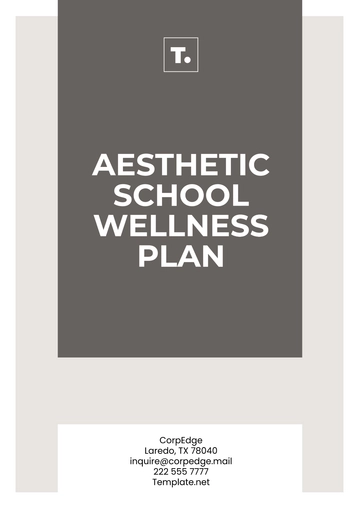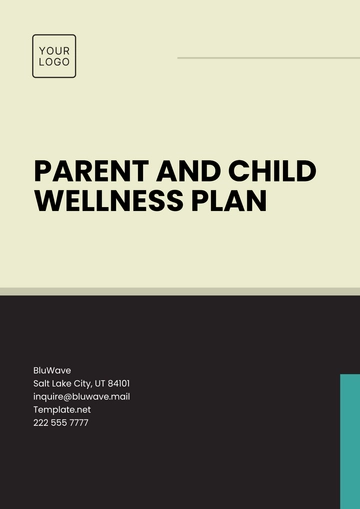Free Wellness Plan for People with Disabilities

Prepared by: [Your Name]
Company: [Your Company Name]
Date: [Insert Date]
I. Introduction
The Wellness Plan for People with Disabilities is a comprehensive framework designed to enhance the quality of life for individuals with disabilities. It focuses on promoting physical, emotional, social, and mental well-being through tailored strategies, resources, and support systems. This plan acknowledges the unique challenges faced by people with disabilities and aims to foster independence, inclusion, and overall health.
II. Vision and Goals
Vision:
To create an inclusive environment that empowers individuals with disabilities to lead fulfilling lives through access to personalized wellness programs, community support, and essential resources.
Goals:
Enhance physical health and mobility through adaptive exercise and nutrition.
Support mental health and emotional well-being with counseling and mindfulness strategies.
Foster social inclusion and community engagement.
Provide accessible healthcare and preventive care services.
Promote independence and self-advocacy through education and empowerment.
III. Key Areas of Focus and Strategies
A. Physical Health and Mobility
Strategies:
Adaptive Fitness Programs:
Offer tailored exercises such as chair yoga, aquatic therapy, and adaptive sports to improve physical fitness and mobility.
Physical Therapy:
Provide personalized therapy plans to address specific mobility challenges and improve functional independence.
Nutrition and Diet Planning:
Develop customized meal plans that address individual health needs, ensuring adequate nutrition for overall well-being.
Assistive Technology:
Ensure access to mobility aids, prosthetics, and other adaptive tools to improve physical independence.
B. Mental and Emotional Well-Being
Strategies:
Mental Health Support:
Provide access to licensed counselors or therapists experienced in working with people with disabilities.
Offer group therapy and peer support programs.
Mindfulness and Relaxation Techniques:
Teach stress management strategies, including meditation, deep breathing exercises, and progressive muscle relaxation.
Creative Therapy:
Encourage participation in art, music, or drama therapy to promote emotional expression and mental health.
Resilience Training:
Build coping skills to manage challenges and enhance emotional resilience.
C. Social Inclusion and Community Engagement
Strategies:
Community Activities:
Organize events like adaptive sports tournaments, art exhibits, or inclusive social gatherings.
Peer Support Groups:
Facilitate support groups where individuals can share experiences, advice, and encouragement.
Volunteer and Work Opportunities:
Collaborate with local organizations to provide accessible employment and volunteer opportunities.
Education for Inclusion:
Educate communities about disability rights, inclusion, and ways to support individuals with disabilities.
D. Accessible Healthcare and Preventive Care
Strategies:
Routine Health Check-Ups:
Schedule regular medical, dental, and vision exams to maintain overall health.
Preventive Screenings:
Promote early detection of health issues through preventive screenings tailored to individual needs.
Accessibility in Healthcare Settings:
Ensure clinics and hospitals are equipped with ramps, lifts, and trained staff to accommodate people with disabilities.
Telehealth Services:
Provide remote healthcare options for individuals with limited mobility or transportation challenges.
E. Independence and Self-Advocacy
Strategies:
Life Skills Training:
Offer programs that teach financial management, cooking, and other essential skills to enhance independence.
Technology Training:
Provide training on using assistive technology and devices to improve communication and accessibility.
Self-Advocacy Workshops:
Educate individuals about their rights and equip them with the skills to advocate for themselves in healthcare, employment, and education.
Career and Education Support:
Assist with job placement, resume building, and access to continuing education opportunities.
IV. Implementation Plan
A. Roles and Responsibilities
Individuals and Families: Actively participate in wellness activities and communicate needs with caregivers and support teams.
Healthcare Providers: Deliver adaptive medical care, preventive services, and therapy tailored to individual needs.
Community Organizations: Offer accessible programs and events to promote inclusion and engagement.
Government and Advocacy Groups: Support policy changes and resource allocation for disability-inclusive programs.
B. Timeline
Phase 1 (1-3 Months): Conduct assessments to determine individual needs, set wellness goals, and provide initial resources.
Phase 2 (3-6 Months): Implement physical, mental, and social wellness programs while monitoring progress.
Phase 3 (6+ Months): Evaluate outcomes, refine programs, and continue promoting long-term independence and health.
V. Evaluation and Monitoring
A. Metrics for Success
Physical Health: Improvements in mobility, strength, and chronic condition management.
Mental Health: Reduced symptoms of stress, anxiety, and depression.
Social Engagement: Increased participation in community events and peer groups.
Independence: Progress in life skills, self-advocacy, and daily living tasks.
B. Methods of Evaluation
Regular check-ins with participants and caregivers.
Surveys and feedback forms to assess satisfaction and areas for improvement.
Periodic reviews of individual wellness plans to track progress and make adjustments.
VI. Sustainability Plan
Funding and Partnerships: Secure financial support through grants, donations, and collaborations with community organizations.
Volunteer Programs: Engage volunteers to support wellness activities and mentoring programs.
Continuous Training: Provide ongoing education for staff, caregivers, and volunteers on best practices for supporting individuals with disabilities.
Community Advocacy: Raise awareness and promote policies that prioritize accessibility and inclusion.
VII. Conclusion
This Wellness Plan for People with Disabilities serves as a roadmap for achieving holistic health and well-being. By addressing physical, mental, social, and independence-related goals, the plan promotes a higher quality of life and fosters a sense of empowerment and belonging. Through community collaboration, accessible resources, and personalized support, this plan ensures that individuals with disabilities have the tools and opportunities to thrive.
- 100% Customizable, free editor
- Access 1 Million+ Templates, photo’s & graphics
- Download or share as a template
- Click and replace photos, graphics, text, backgrounds
- Resize, crop, AI write & more
- Access advanced editor
You may also like
- Finance Plan
- Construction Plan
- Sales Plan
- Development Plan
- Career Plan
- Budget Plan
- HR Plan
- Education Plan
- Transition Plan
- Work Plan
- Training Plan
- Communication Plan
- Operation Plan
- Health And Safety Plan
- Strategy Plan
- Professional Development Plan
- Advertising Plan
- Risk Management Plan
- Restaurant Plan
- School Plan
- Nursing Home Patient Care Plan
- Nursing Care Plan
- Plan Event
- Startup Plan
- Social Media Plan
- Staffing Plan
- Annual Plan
- Content Plan
- Payment Plan
- Implementation Plan
- Hotel Plan
- Workout Plan
- Accounting Plan
- Campaign Plan
- Essay Plan
- 30 60 90 Day Plan
- Research Plan
- Recruitment Plan
- 90 Day Plan
- Quarterly Plan
- Emergency Plan
- 5 Year Plan
- Gym Plan
- Personal Plan
- IT and Software Plan
- Treatment Plan
- Real Estate Plan
- Law Firm Plan
- Healthcare Plan
- Improvement Plan
- Media Plan
- 5 Year Business Plan
- Learning Plan
- Marketing Campaign Plan
- Travel Agency Plan
- Cleaning Services Plan
- Interior Design Plan
- Performance Plan
- PR Plan
- Birth Plan
- Life Plan
- SEO Plan
- Disaster Recovery Plan
- Continuity Plan
- Launch Plan
- Legal Plan
- Behavior Plan
- Performance Improvement Plan
- Salon Plan
- Security Plan
- Security Management Plan
- Employee Development Plan
- Quality Plan
- Service Improvement Plan
- Growth Plan
- Incident Response Plan
- Basketball Plan
- Emergency Action Plan
- Product Launch Plan
- Spa Plan
- Employee Training Plan
- Data Analysis Plan
- Employee Action Plan
- Territory Plan
- Audit Plan
- Classroom Plan
- Activity Plan
- Parenting Plan
- Care Plan
- Project Execution Plan
- Exercise Plan
- Internship Plan
- Software Development Plan
- Continuous Improvement Plan
- Leave Plan
- 90 Day Sales Plan
- Advertising Agency Plan
- Employee Transition Plan
- Smart Action Plan
- Workplace Safety Plan
- Behavior Change Plan
- Contingency Plan
- Continuity of Operations Plan
- Health Plan
- Quality Control Plan
- Self Plan
- Sports Development Plan
- Change Management Plan
- Ecommerce Plan
- Personal Financial Plan
- Process Improvement Plan
- 30-60-90 Day Sales Plan
- Crisis Management Plan
- Engagement Plan
- Execution Plan
- Pandemic Plan
- Quality Assurance Plan
- Service Continuity Plan
- Agile Project Plan
- Fundraising Plan
- Job Transition Plan
- Asset Maintenance Plan
- Maintenance Plan
- Software Test Plan
- Staff Training and Development Plan
- 3 Year Plan
- Brand Activation Plan
- Release Plan
- Resource Plan
- Risk Mitigation Plan
- Teacher Plan
- 30 60 90 Day Plan for New Manager
- Food Safety Plan
- Food Truck Plan
- Hiring Plan
- Quality Management Plan
- Wellness Plan
- Behavior Intervention Plan
- Bonus Plan
- Investment Plan
- Maternity Leave Plan
- Pandemic Response Plan
- Succession Planning
- Coaching Plan
- Configuration Management Plan
- Remote Work Plan
- Self Care Plan
- Teaching Plan
- 100-Day Plan
- HACCP Plan
- Student Plan
- Sustainability Plan
- 30 60 90 Day Plan for Interview
- Access Plan
- Site Specific Safety Plan





























